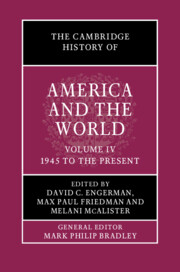Book contents
- The Cambridge History of America and the World
- The Cambridge History of America and the World
- The Cambridge History of America and the World
- Copyright page
- Contents
- Figures
- Maps
- Contributors to Volume IV
- General Introduction: What is America and the World?
- Introduction to Volume IV
- Part I Ordering a World of States
- 1 Global Capitalist Infrastructure and US Power
- 2 Overseas Bases and the Expansion of US Military Presence
- 3 The Consolidation of the Nuclear Age
- 4 American Knowledge of the World
- 5 The American Construction of the Communist Threat
- 6 The Fractured World of the Cold War
- 7 The US and the United Nations System
- 8 American Development Aid, Decolonization, and the Cold War
- 9 Decolonization and US Intervention in Asia
- Part II Challenging a World of States
- Part III New World Disorder?
- Index
5 - The American Construction of the Communist Threat
from Part I - Ordering a World of States
Published online by Cambridge University Press: 12 November 2021
- The Cambridge History of America and the World
- The Cambridge History of America and the World
- The Cambridge History of America and the World
- Copyright page
- Contents
- Figures
- Maps
- Contributors to Volume IV
- General Introduction: What is America and the World?
- Introduction to Volume IV
- Part I Ordering a World of States
- 1 Global Capitalist Infrastructure and US Power
- 2 Overseas Bases and the Expansion of US Military Presence
- 3 The Consolidation of the Nuclear Age
- 4 American Knowledge of the World
- 5 The American Construction of the Communist Threat
- 6 The Fractured World of the Cold War
- 7 The US and the United Nations System
- 8 American Development Aid, Decolonization, and the Cold War
- 9 Decolonization and US Intervention in Asia
- Part II Challenging a World of States
- Part III New World Disorder?
- Index
Summary
As World War II came to a close, the Soviet Union and the United States competed to structure a new order for a world destroyed. Within just a few short years, alliance turned to rivalry, then to enmity. American political leaders came to see the Soviet Union – with its crusading propaganda machine, its vast army, its menacing international behavior, and its repressive centralized state – as an existential threat. Historians continue to debate whether the policy response, “containment,” derived from a realistic or exaggerated assessment of Soviet actions and intentions. There can be little doubt, however, that Americans understood themselves to be reacting defensively to a growing danger. Still, it would be a mistake to conclude that international developments alone drove US policy, for the image of the communist threat was also colored by the domestic context that framed American perceptions of the world.
- Type
- Chapter
- Information
- The Cambridge History of America and the World , pp. 124 - 147Publisher: Cambridge University PressPrint publication year: 2022

